"In the Search for Life on Titan, the Challenge Will Be Recognizing It.", by C. Zimmer, New York Times, January 11 2005, D3
A discussion concerning non-DNA-based life and life that may exist without water.
"How was membrane permeability produced in an RNA world?", A. Vlassov, Origins of Life and Evolution of Biospheres, April, 2005, 35, 2, 135-149
Investigations of the construction of semipermiable membranes from supramolecular RNA complexes supporting encapsulation of catalysts.
"The two ages of the RNA world, and the transition to the DNA world: a story of viruses and cells", by P. Forterre, Biochimie, Sept.-Pct. 2005, 87, 9-10, 793 - 803
The consensus among evolutionists is that the DNA genomes were preceeded by RNA genomes. However, there is no consensus about what this "RNA world" means. In an RNA world, either RNA molecules are considered as "living molecules", else the RNA world must be viewed as "prebiotic". Only the late emergence of cellular membranes could explain archaeal lipids being so different from eucaryotic/bacterial lipids. Such a viewpoint implies an acellular Last Universal Common Ancestor or LUCA: contradicted by phylogenomic analysis (several membrane-related proteins were present in LUCA). Thus the view that LUCA was cellular.
A major step in the evolution of the RNA world was the emergence of the ribozyme ancestor of today's ribosomes: the establishment of the first version of a genetic code of proteins, but by RNA. Early RNA cells may have synthesized proteins or protein-loke molecules by pathways that no longer exist.
In an RNA world, it is likely that cells and mtDNA.html#VIROID virus-like organisms (such as viroids) existed in a competitive evolutionary environment. As all present-day viruses contain proteins, the viruses in the RNA world likely originated as RNA viruses or viroids (viruses were reduced to parasitic living as their cellular lineages lost out in Darwinian selection). See Fig. 1.
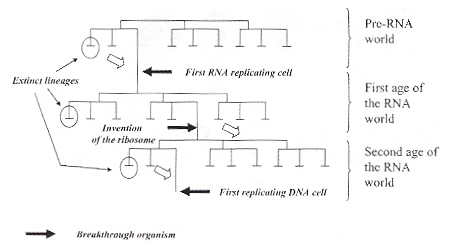
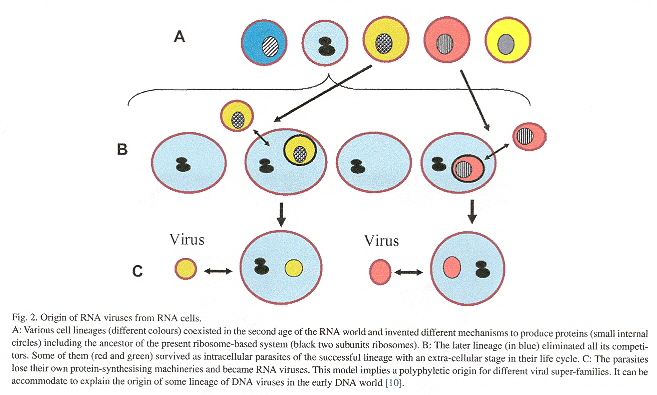
Did DNA appear during the first or second age of the RNA world? Rephrased, did a ribozyme transform RNA into DNA? rNTP (ribonuclease triphosphate) is an RNA precursor, and rNTP is convertible into dNTP (deoxyribonuclease triphosphate) which is a precursor of DNA. Furthermore, ribonucleotide reductases catalyse the conversion or rNTP into dNTP. Thus DNA does not originate from RNA, rather RNA was modified into DNA by protein enzymes. Thus DNA appeared during the second stage of the RNA world.
To accomplish all this, complex RNA cells but with limited RNA genomes might seem incapable? Yet RNA damage repair and RNA polymerases to maintain RNA fidelity do exist. In addition, there is evidence that the conversion from the RNA world to the DNA world most likely took place more than once. Also, RNA viruses are protected by the viral capsid.
Various virus possibilities can be imagined, as well as currently existing viral examples:
- Single-stranded RNA with double-strand RNA replication
- Single-stranded DNA with DNA/RNA double-strand replication
A genomic size-limit of viruses, thus the viral genomes became DNA plasmids. It is likely that plasmids evolved from viruses, rather than the other way around.
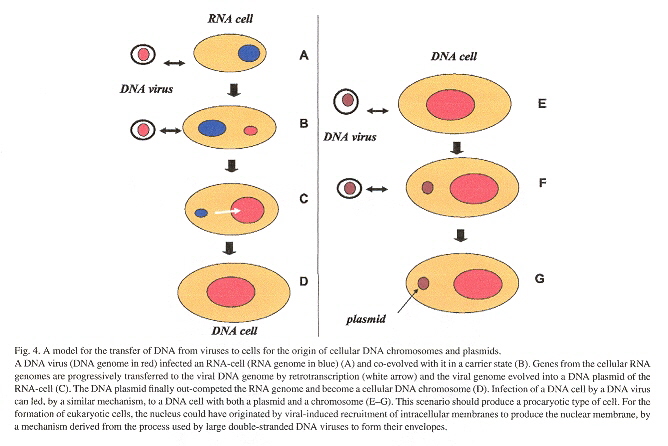
Assuming that the transfer of DNA from viruses to cells occurred at a late evolutionary stage of DNA replication, then this would have taken place before DNA cell lineages had been established.
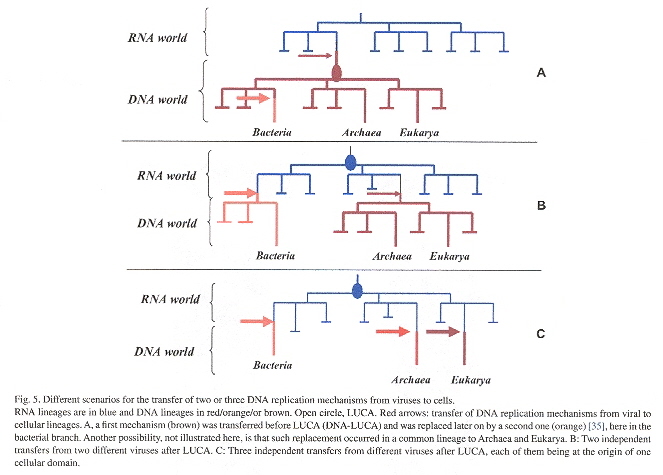
Large DNA viruses at the origin of three cellular domains (Bacteria, Archaea, Eukarya) that encoded RNA polymerases. The beginning ancestor of each of these three domains originated from the transition of an RNA-cell into a DNA-cell via a virus.
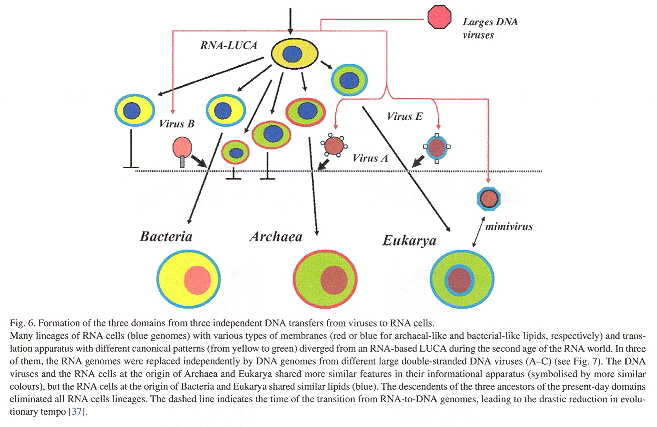
"The RNA World on Ice: A New Scenario for the Emergence of RNA Information", by A. V. Vlassov, S. A. Kazakov, B. H. Johnston, L. F. Landweber, Journal of Molecular Evolution, Aug. 2005, 61, 2, 264 - 273
As proteins cannot replicate themselves, the discovery of RNA catalysis to encode proteins provided a method of explaining the early evolution of life: before DNA encoded protein life evolved. Evolution in an RNA world requires four processes: replication, cellularization, translation, and metabolism. Problems yet to be explained in an RNA world include membrane permeability and how could long, complex RNA molecules form and survive? Experiments showing how RNA ligation could take place were performed. In particular, evolution under freezing conditions (neither too cold nor too warm) allow optimal conditions for ligation to proceed:
- Freezing accelerates some reactions by concentration of reactants
- Freezing reduces water in solution thus lowering the activity of water
- Increased salt concentrations with freezing shields interphosphate repulsion
- Freezing reduces RNA degradation
Reverse Evolution to find simpler precursors of RNA yielded interesting molecules.
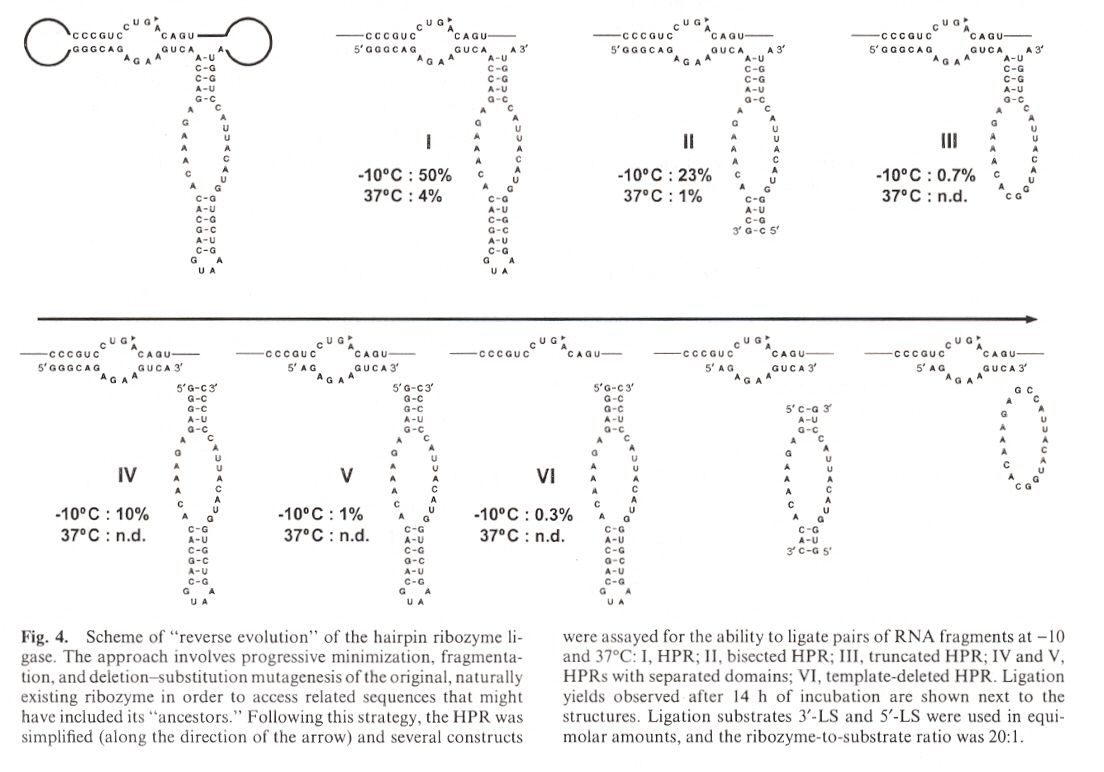
"RNA world and its evolution", by A. S. Spirin, Molecular Biology, 2005, 39, 4, 550 - 556
Evidence that RNA preceeded DNA includes:
- Genetic functions of RNA a, b
- RNA (not DNA) directly participates in the biosynthesis of proteins
- RNA is located in different parts of the protoplasm
- All four ribonucleotides (not deoxyribonucleotides) participate in components of metabolism
The discovery of ribozymes indicated that RNA could act as a catalyst without the participation of either DNA or proteins. Thus the RNA world could be based upon self-replication without proteins, as supported by the existence of RNA-based viral replication (viewed as a relic from the past). In fact, the discovery of interfearing RNA (iRNA) also supports such a pre-DNA world.
It is assumed that oligonucleotides originated abiologically by polymerizing on clay surfaces. Such mechanizms occured through simple probable chance events, but were also supplementd by constant-acting mechanisms. Specifically, RNA molecules can spontaneously rearrange their nucleotide sequences in the absence of either protein enzymes or ribozymes (both by cis and trans exchanges) c. Spontaneous oligonucleotide elongation also takes place. It is thus possible to evolve ribozymes by spontaneous rearrangemts and spontaneous elongation.
Before natural selection can operate, some form of compartmentalization is necessary. However, such a form of compartmentalization before proteins and lipids existed. This could have happened in "Darwin's ponds". Mixed types of colonies of RNA could have been the first acellular ensembles: one type performing genetic replication, another type creating different structures. Such RNA mixed-colony compartmentalization leads to natural selection between different ponds of colonies. Specifically, by the "SELEX" mechanism (Systematic Evolution of Ligands by EXponential enrichment) d. To be explicit, "SELEX" means:
- Different RNA-replicating ribozymes in the same puddle-colony, increase the different RNA by spontaneous increase by elongation and replication mistakes
- As puddles dry, RNA molecules bind and with ribozyme action, colonies of mixed RNA types grow, the more successful ones growing faster (the increased RNA species being the basis of natural selection)
- Dry puddles become flooded, dissolving theses puddle-colonies, but the colonies are now enriched by different molecular species
Thus alternate flooding and drying provides a systematic enrichment of RNA mixes, by a naturally selective process. Cells with cell membranes based upon proteins and lipids were not necessary for RNA compartmentalization.
a "Infectivity of ribonucleic acid from tobacco mosaic virus", by A. Gierer, G. Schramm, Nature, 1956, 177, 702 - 703
b "Infectivity of viral nucleic acid", by H. Fraenkel-Conrat, B. Singer, R. C. Williams, Biochemical and Biophysical Acta, 1957, 25, 87 - 96
c "Spontaneous rearrangements in RNA sequences", by H. V. Chetverina, A. A. Demidenko, V. I. Ugarov, A. B. Chetverin, 1999, FEBS Letters, 450, 89 - 94
d "Systematic evolution of ligands by exponential enrichment", by C. Tuerk, L. Gold, Science, 1990, 249, 505 - 510
"Peptides and the origin of life", by B. M. Rode, Peptides, 1999, 20, 6, 773 - 786
The experiments by Urey, Miller, and several others, showed that starting with simple reactants such as CH4, NH3, H2O, H2, etc. in the presence of electric discharges, UV light, etc, many amino acids, sugars, and nucleic bases naturally result. Furthermore, in the early Earth prebiotic environment, salts and ions must have been common, such as NaCL, CuCL2, Ca++, etc. These salts and ions in such an amino-acid environment easily yield di- and tri-peptides. This environment is referred to as the "SIPF" ("Salt Induced Peptide Formation") environment. The authors show how CL– greatly facilitate peptide linkage to form dipeptides. Given time, many polypeptide sequences could develope that in the presence of clays (that could protect against hydrolysis), help the elongation of polypeptide chains. The discovery that peptides can self-replicate allows one to envision a "protein world", but a world where RNA and DNA need yet to be explained in the evolutionary process.
"A model for the role of short self-assembled peptides in the very early stages of the origin of life", by O. Carney, E. Gazit, Federation of American Societies for Experimental Biology, July 2005, 19, 9, 1051 - 1055
There are two major hypotheses to explain the origin of life. One hypothesis is the "RNA world", the other hypotheses is the "Protein world". This paper attempts an escape through the horns of the dilemma. Short peptide sequences (dipeptides and tripeptides) can generate in the early, prebiotic earth (or even be seeded from carbonaceous chondritic meteorites: comets and asteroids). Simple peptides can bind with and recognize specific nucleotides into a self-assembling system to stabilize RNA until by chance, RNA polymerase is sythesized. Such self-assembled molecules can take on the form of a self-assembling nanotube, and such hollow structures can trap solvents. This could explain the development of encapulating structures, forming amyloid like peptides.
"Synthesizing life", by J. W. Szostak, D. P. Bartel, P. L. Luisi, Nature, Jan. 18 2001, 409, 6818, 387 - 390
A living cell requires two conditions at a minimum: autonomous replication and darwinian evolution. To accomplish autonomous replication, an RNA replicase is required (capable of storing genetic information as well as polymerase replication). Compartmentalization to keep a replicating ploymerase and a template together to allow preferential replication to take place. As all cell membranes are construced from lipids, a protocell requires a lipid membrane that is also a replicating membrane. A good candidate would be a ribozyme that synthesizes amphiphatic lipids. So far, anything close to an RNA replicase uses activated nucleoside triphosphates. Such a self-replicating lipid vesicle containing an RNA replicase, subject to darwinian selection could then be said to be living.
"In Search of an RNA Replicase Ribozyme", by K. E. McGinness, G. F. Joyce, Chemistry & Biology, Jan. 2003, 10, 1, 5 - 14
An important paper that reports the use of in vitro evolution (a random pool of RNA molecules challenged to bind a primer molecule through Watson-Crick pairing and catalyze RNA ligation, then selectively amplified). A series of ligase ribozymesed were isolated. Such RNA with polymerase activity are being further elaborated with the object of obtaining an in vitro RNA replicase.